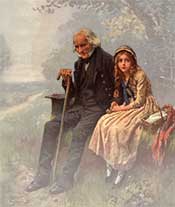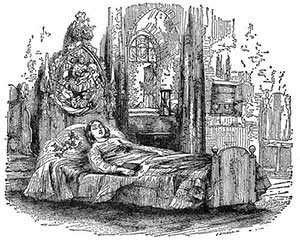Charles Dickens'
The Old Curiosity Shop
The Old Curiosity Shop - A Tale
The Old Curiosity Shop - Published in weekly parts Apr 1840 - Feb 1841
Charles Dickens' fourth novel was illustrated by George Cattermole and Phiz, with a single illustration each from Samuel Williams and Daniel Maclise.This installment novel, published in Master Humphrey's Clock, was so popular that its weekly sales rose to a hundred thousand (Patten, 1978, p. 110). It tells the story of Nell Trent and her grandfather as they wander the English countryside, northwest of London, trying to evade Daniel Quilp, probably Dickens' most evil villain. Nell's grandfather has borrowed money from Quilp to support a gambling habit and has lost everything, including the curiosity shop.
The tale is richly populated with the interesting and bizarre cast of characters Nell and her grandfather meet along their journey.
As the conclusion of the story neared Nell is exhausted from the travel and lack of food. Dickens was inundated with letters begging him to spare Nell's life (Slater, 2009, p. 158). Dickens confided to George Cattermole, one of the illustrators of the book, that "I am breaking my heart over this story" (Ackroyd, 1990, p. 318).
With the final installment arriving by ship, crowds in New York shouted from the pier "Is Little Nell dead?" (Ackroyd, 1990, p. 319)
Master Humphrey's Clock
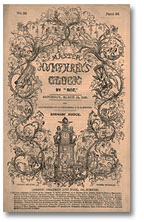 Dickens began the serialization of The Old Curiosity Shop in his weekly miscellany Master Humphrey's Clock, the plan being to continue the tale from time to time amidst other articles as the mood took him. The story, however, captured the imagination of both Dickens and his readers and soon took over the entire publication. Dickens, feeling rather cramped within the confines of the Clock, allowed the story to burst out beginning with chapter four (Slater, 2009, p. 152). Thus, at the end of chapter three, he has Master Humphrey, heretofore acting as narrator, inform the readers:
Dickens began the serialization of The Old Curiosity Shop in his weekly miscellany Master Humphrey's Clock, the plan being to continue the tale from time to time amidst other articles as the mood took him. The story, however, captured the imagination of both Dickens and his readers and soon took over the entire publication. Dickens, feeling rather cramped within the confines of the Clock, allowed the story to burst out beginning with chapter four (Slater, 2009, p. 152). Thus, at the end of chapter three, he has Master Humphrey, heretofore acting as narrator, inform the readers:
And now that I have carried this history so far in my own character and introduced these personages to the reader, I shall for the convenience of the narrative detach myself from its further course, and leave those who have prominent and necessary parts in it to speak and act for themselves (The Old Curiosity Shop, p. 28).
In the original serialization of the novel the grandfather's brother, the single gentleman, turns out to be none other than Master Humphrey himself.
Complete List of Characters:
Character descriptions contain spoilersOld Curiosity Shop Links:
The Victorian WebBartleby.com
Wikipedia
Herb Moskovitz's excellent article Punch and Dickens
The Old Curiosity Shop-Holborn
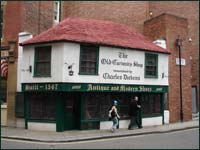
The Old Curiosity Shop on Portsmouth Street in Holborn, dating from 1567 and said to be constructed from salvaged ship wood, survived both the Great Fire of London in 1666 and the Blitz during World War II. It is erroneously thought to be the inspiration for the shop in the novel although evidence seems to show that the name was changed after the book was published (Charles Dickens Museum).
Mapping Little Nell's Journey

Explore a map of the probable route along with some evidence to support it.
Pain no longer?
The inspiration for Nell is believed to be Charles Dickens' sister-in-law, Mary Hogarth. Dickens was devoted to his wife's younger sister and when she died suddenly in 1837 at the age of 17 he was devastated. He took a ring from Mary's finger and wore it the rest of his life, he also said that he wanted to be buried in the same grave as Mary.
However, several passages in The Old Curiosity Shop perhaps reveal a coming-to-terms with the loss of Mary three years earlier. In chapter 17 the old woman visiting the grave of her husband who died a young man tells Nell that early in her grief she came there to cry and mourn and hoped to die too but that now it is "pain no longer, but a solemn pleasure" to visit the grave.
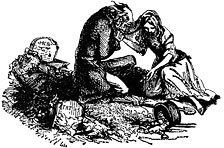 In chapter 26, as Nell is visiting the graves of children in the churchyard, the narrator says that she did not sufficiently consider to what a bright and happy existence those who die young are borne, and how in death they lose the pain of seeing others die around them.
In chapter 26, as Nell is visiting the graves of children in the churchyard, the narrator says that she did not sufficiently consider to what a bright and happy existence those who die young are borne, and how in death they lose the pain of seeing others die around them.
In chapter 54, as Nell laments the uncared-for graves in the churchyard, the sexton tells her that at first the graves are tended every day by "tender, loving friends" but later the tending falls to once a week, then once a month, and later not at all. As Nell says she grieves to hear it, the old man says that on the contrary, he takes it as a good sign for the happiness of the living.
Later in chapter 54 Nell is speaking with the schoolmaster in the neglected churchyard and says she "grieves to think that those who die about us are so soon forgotten" he tells her that the unvisited graves are the inspiration of good actions and good thoughts of those who remember the dead and have chosen to go on living.
Deathbed of Little Nell
Charles Dickens' instructions to George Cattermole for the illustration The Death-Bed of Little Nell:
"The child lying dead in the little sleeping room, which is behind the open screen. It is winter-time, so there are no flowers; but upon her breast and pillow, and about her bed, there may be strips of holly and berries, and such free green things. Window overgrown with ivy. The little boy who had that talk with her about angels may be by the bedside, if you like it so; but I think it will be quieter and more peaceful if she is alone. I want it to express the most beautiful repose and tranquility, and to have something of a happy look, if death can...I am breaking my heart over this story, and cannot bear to finish it" (Letters, 1969, v. 2, p. 171-172).Thomas Moore
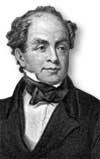 Thomas Moore
Thomas MooreO'Sullivan gives the following example of Swiveller quoting from Moore's Holy Be the Pilgrim's Sleep:
In chapter 65 Dick Swiveller, recovering from brain fever, is being tenderly nursed by the faithful little Marchioness, who has run away from Sampson Brass's: Having eaten and drunk to Mr. Swiveller's extreme contentment, given him his drink, and put everything in neat order, she wrapped herself in an old coverlet and lay down upon the rug before the fire. Mr. Swiveller was by that time murmuring in his sleep, 'Strew then, oh strew a bed of rushes. Here will we stay, till morning blushes. Good night, Marchioness!' (The Old Curiosity Shop, p. 488)
As a testament to Dickens' love of Thomas Moore, Peter Ackroyd reports in his biography, Dickens, that in order to protect his voice during the 1858 reading tour, Dickens "dosed himself regularly with barley water and mustard poultices" and sang Moore's Irish Melodies as he walked along (Ackroyd, 1990, p. 836).
- Sketches by Boz |
- Pickwick |
- Oliver Twist |
- Nickleby |
- Old Curiosity Shop |
- Barnaby Rudge |
- Chuzzlewit |
- Christmas Carol |
- Christmas Books |
- American Notes |
- Pictures from Italy |
- Dombey and Son |
- Copperfield |
- Bleak House |
- Hard Times |
- Little Dorrit |
- Tale of Two Cities |
- Great Expectations |
- Our Mutual Friend |
- Edwin Drood |
- Minor Works |
- The Uncommercial Traveller |
- Short Stories

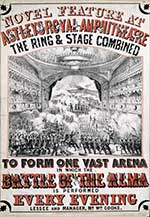
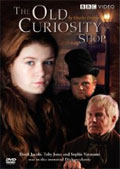

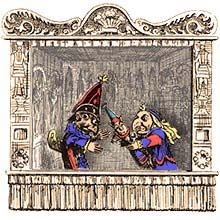
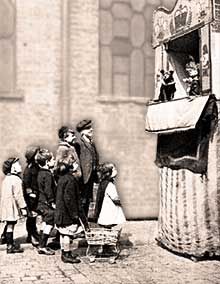

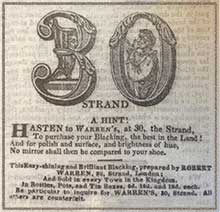
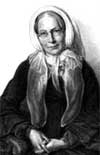 One of the quotations used by the loquacious Dick Swiveller, in this case referring to Kit's mother, is "Who ran to catch me when I fell, and kissed the place to make it well? My Mother"
One of the quotations used by the loquacious Dick Swiveller, in this case referring to Kit's mother, is "Who ran to catch me when I fell, and kissed the place to make it well? My Mother" 